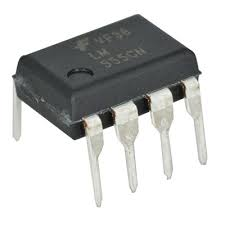LM555CN
Part Number: LM555CN
Manufacturer: onsemi
Description: IC OSC SINGLE TIMER 8-DIP
Shipped from: Shenzhen/HK Warehouse
Stock Available: Check with us
ICRFQ.com - Electronic Components Distributor in China Since 2003

Part Number: LM555CN
Manufacturer: onsemi
Description: IC OSC SINGLE TIMER 8-DIP
Shipped from: Shenzhen/HK Warehouse
Stock Available: Check with us
| Datasheet | |
|---|---|
| Category | Integrated Circuits (ICs) |
| Family | Clock/Timing – Programmable Timers and Oscillators |
| Manufacturer | Fairchild Semiconductor |
| Series | – |
| Packaging | Tube |
| Part Status | Active |
| Type | 555 Type, Timer/Oscillator (Single) |
| Count | – |
| Frequency | – |
| Voltage – Supply | 4.5 V ~ 16 V |
| Current – Supply | 7.5mA |
| Operating Temperature | 0°C ~ 70°C |
| Package / Case | 8-DIP (0.300″, 7.62mm) |
| Supplier Device Package | 8-DIP |
| Mounting Type | Through Hole |
The LM555CN is the best choice if you need a dependable and flexible integrated circuit for timing, oscillation, or pulse production. Because of its monostable and stable behaviour, the delay, frequency, and duty cycle of the timing pulses it produces can be precisely adjusted with only a few external components. The LM555CN excels in applications requiring precise timing, pulse generation, delay generation, and sequential timing thanks to its high-current driving capability, adjustable duty cycle, and timing range of microseconds to hours.
The LM555CN and the NE555 serve the same purpose. However, the LM555CN has a broader operating temperature range, lower power consumption, and greater maximum supply voltage. Like any other integrated circuit, the LM555CN has several drawbacks, such as a narrow operating voltage and current range, sensitivity to noise, and a lower maximum frequency. Despite this, the LM555CN is still one of the most widely used integrated circuits (ICs) due to its low price, great dependability, and ease of implementation.
Look no further than the LM555, a highly reliable controller for precise timing pulses. The monostable operation allows the delay to be adjusted with just one external component (a resistor and a capacitor). The astable operation allows for precise regulation of frequency and duty cycle through two external resistors and a single capacitor.
The gadget could be broken if the stress levels rise above the maximum allowed. It is not advised to subject the device to conditions outside the recommended working range, as this could cause the gadget to break down or become inoperable. Moreover, device reliability may be compromised by prolonged exposure to forces more than the specified operating conditions. All stress ratings are absolute maximums. Except where otherwise specified, all values are given at a temperature of TA = 25°C.
Timer integrated circuits (ICs) like the LM555 and NE555 are ubiquitous in electronic design. Both ICs are made to provide electronic circuits with precise and dependable time delays or oscillations. Regarding their intended purposes, the LM555 and NE555 are indistinguishable. Both devices share the same pinout and electrical properties, including input-to-output voltage range, trigger voltage, and drive capability at the output.
National Semiconductor and Signetics are responsible for introducing the LM555 and the NE555 (now part of NXP Semiconductors). Although they perform the same functions, the LM555 and NE555 differ in key ways.
The temperature range represents a key distinction between the two. The LM555 has a greater temperature range of operation, from -55 degrees to 125 degrees Celsius, while the NE555’s range is only from -40 degrees to 85 degrees Celsius.
There is also a distinction between the LM555 and the NE555 in terms of the maximum supply voltage that the manufacturer advises. A maximum supply voltage of 16 volts is supported by the LM555, while the NE555 supports a maximum of 15 volts.
The LM555 is preferable for battery-operated devices because it consumes less power than its counterpart, the NE555.
Finally, the LM555 and the NE555 may differ in performance in some applications due to tiny variances in their internal circuitry.
Despite these distinctions, the LM555 and NE555 share a great deal of functional similarity and are both frequently employed in various applications, including timing, oscillators, and pulse-width-modulation (PWM) circuits.
In electronic circuits, a 555-timer IC is commonly used for timing, oscillation, and pulse production. Signetics Company launched the IC in 1971, and since then, it has risen to prominence as one of the most widely used and flexible ICs available.
The 555 timer IC can perform a wide variety of timing and pulse generation operations thanks to its several functional blocks, which include a voltage divider, comparators, flip-flops, and output drivers. The IC can be used for a wide variety of tasks due to its ability to switch between monostable (one-shot), astable (oscillator), and bistable (flip-flop) modes of operation.
Timing, pulse width modulation (PWM), tone production, driving LEDs and relays, and other similar tasks are only some of the many uses for the ubiquitous 555 timer IC in electrical circuits. Its widespread acceptance can be attributed to these three factors and its low price and versatility in terms of operating temperature and power supply.
Many benefits and drawbacks of using the 555 timer IC are outlined below:
Finally, the LM555CN is a time-tested controller that has proven its adaptability, stability, and reliability. It’s widely used because of its low price, simplicity, and reliability in various electronic circuits. To get the most out of it, you need to use high-quality parts and a well-thought-out layout.
If you want to experience the power and versatility of the LM555CN, contact ICRFQ, your trusted electronic component distributor in China. We offer a wide range of quality electronic components, including the LM555CN, at competitive prices. Don’t hesitate to contact us today and take your electronic designs to the next level.
WhatsApp us